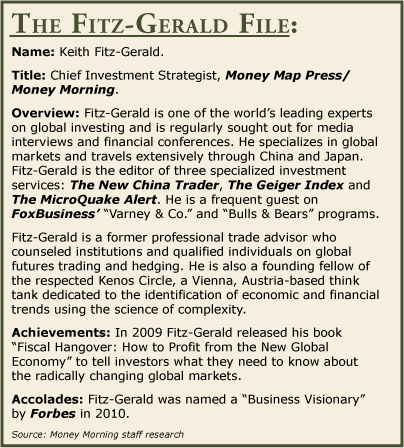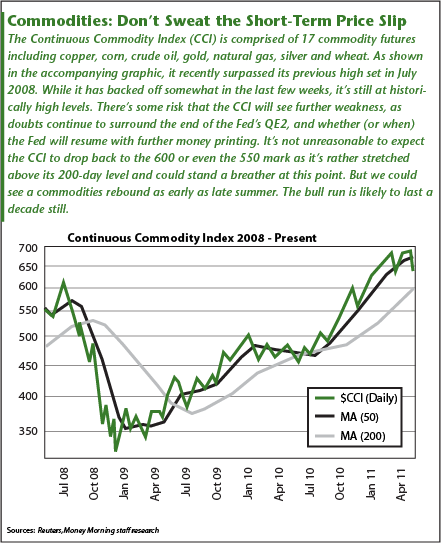To hear the mainstream media tell it, the commodities bubble has burst.
Commodities are plunging across the board in response to the latest U.S. data, most of which seems to suggest that the American economic recovery is waning. Oil, which traded down to $94.63 on Friday, was particularly hard hit, which is why so many suggest the commodities bubble has met its end.
Don't you believe it.
Commodities prices will be back. In fact, 12 months to 24 months from now, gold, silver and other commodities will be trading at higher prices than they were just a few weeks ago - when they were trading at record levels.
"Pit Panic" and the Commodities Bubble
Though you may be surprised by my predictions, I have to confess that this isn't rocket science. Several clues point the way. For instance:
- Global demand is still rising and in the "BEE" markets (Big Emerging Economies), demand is advancing well ahead of the global averages.
- We're using four barrels of oil for every one we're discovering, and unless you've got a few million years to wait, Mother Nature isn't going to bail us out any time soon.
- Alternatives for energy-related commodities - and particularly oil - are few and far between. For instance, there are more than 60,000 industrial processes that depend on petroleum-based products, which is why even the most aggressive scientists think it could be decades before substitutes are robust enough to actually reduce oil demand. And that's assuming a perfect substitute is found today.
The way I see it, the situation we face in the world today is like a thousand people trying to buy the last egg in the grocery store: Prices have to go up.
That brings us to last week's so-called "pit panic. " Here, too, there were clear catalysts and logical reasons for the actions that traders took as they drove prices into the basement. For instance:

- Many traders are simply taking profits. That's what they do and is how they are bonused, which is why none of them wants to be the last one to leave the party. This places downward pressure on prices. Other traders - who are running high-margin/high-return strategies - are simply liquidating hard assets (including oil) in the face of rumored regulatory changes that would radically elevate their margin requirements just as very similar margin changes took the steam out of silver's sails last week. (The Chicago Mercantile Exchange (Nasdaq: CME) has raised margin requirements on silver contracts five times this month alone.) Ironically, this panic began in the silver pits. And that implosion of silver mania subsequently spread to such commodities as oil and copper in the last few days. This illustrates the interconnectivity of financial markets that I frequently talk about.
- There's perhaps a bit of a "fear premium," even though the Middle East has not gone up in flames and oil is still flowing. Frankly, I think there's a bit of this at play, but it's not a huge factor.
- Oil is traded in U.S. dollars, which means that as oil goes up, the dollar is typically dropping. But traders seem bent on driving oil prices down, which may signal a much darker possibility: These trades may be presaging an attack on U.S. debt that is akin to the attacks on the government liabilities of Greece, Ireland and Portuguese during the past few months - and these attacks sent yields up sharply. This is not unlike actions taken by the bond vigilantes of the 1990s who actively sold T reasuries as a "protest" in an effort to drive rates higher and bond prices lower. This time around, though, I think currencies themselves are the weapon of choice.
There are other reasons why this so-called commodities bubble isn't finished - not by a long shot.
Ingredients for a Commodities-Price Rebound
Not only is the U.S. dollar hobbled, but the fiscal mess Washington has created virtually guarantees that governments around the world are going to actively diversify away from the greenback and into "quasi-currencies," such as oil, which are highly liquid (in the financial sense), easily valued, and easily traded worldwide.
All of this is a function of the U.S. Federal Reserve's "QE2" initiative - the cheap-money flow that central bank Chairman Ben S. Bernanke & Co. has managed to get the U.S. economy (and the U.S. stock market) hooked on.

Looking ahead, there is no doubt that commodities prices - in a tailspin right now - will end up being far higher in the future than they were at their apex during the height of the commodities bubble. The catalysts and scenarios that I've already outlined here would do the job on their own.
But there's still one more factor that points to higher prices down the road - and it may be the most powerful and persuasive reason of all.
Margin calls, profit-taking and panic-selling all serve one important purpose: They effectively eliminate the "nervous money" - the smaller, less-committed, more-uncertain market participants. And that simultaneously clears the decks for those hedge funds and trading firms with the deep pockets, strategic commitment and market resolve to ultimately drive prices far higher.
To employ another analogy, these transitional shifts are a lot like the NFL blockers who clear the path for a star running back ... and having eliminated all those potential tacklers, they enable him to zoom down the sidelines and into the end zone to score.
Moves to Make Now
So what's the bottom line here? What are the lessons to learn from what the pundits are labeling as a burst commodities bubble?
If you missed the previous run up in commodities prices, I don't think you can't ask for a more textbook-perfect second chance to get aboard before prices rebound - even if the selling isn't finished yet.
So don't kick yourself for having missed out on this commodities bubble - the next one isn't far away.
Here are three choices to get you started - one a direct oil play, and the two others strong metals-market plays:
- United States Oil Fund LP (NYSE: USO): The United States Oil Fund is a futures-based exchange-traded fund (ETF) and is one of the world's most popular investments, with more than 13 million shares traded daily. With net assets of $2.17 billion, this fund invests in crude oil, heating oil, gasoline, natural gas, and other exchange-traded and petroleum-related instruments - such as cash-settled options and forward contracts.
- SPDR Gold Trust ETF (NYSE: GLD): Another exchange-traded fund, this trust tracks the price of gold bullion using a combination of deposit exchanges and physical bullion. The ETF has net assets of $56.02 billion and has traded more than 14 million shares a day on average over the last three months.
- iShares Silver Trust ETF (NYSE: SLV): Last, but not least, this ETF tracks the price of silver as closely as possible through the ownership of silver securities that represent fractional interests in the physical silver held by the trust. Like the SPDR Gold Trust, the iShares Silver Trust offers investors the ability to participate in silver investments - but without the risk of physical ownership. It has $13.6 billion in assets and has had an average daily volume of 57.5 million shares over the past three months, which gives it good liquidity.
All you need is the right blend of high-yielding investments - and the right team of financial experts.
And you can get both right here.
This amazing profit opportunity is the latest offer from the global investing gurus with our monthly affiliate, The Money Map Report.
With investors today facing as much market uncertainty as ever, the Money Map team is constantly hunting for the best investments to share with you. Those recommendations, along with our special report on how to double your money, can be yours. Click here to read more.]
News and Related Story Links:
- MarketWatch.com:
Oil Ends 2.6% Lower as Rebound Fizzles. - Money Morning:
The Silver Bull: Despite This Week's Sell-Off, We See Higher Prices Ahead
About the Author
Keith is a seasoned market analyst and professional trader with more than 37 years of global experience. He is one of very few experts to correctly see both the dot.bomb crisis and the ongoing financial crisis coming ahead of time - and one of even fewer to help millions of investors around the world successfully navigate them both. Forbes hailed him as a "Market Visionary." He is a regular on FOX Business News and Yahoo! Finance, and his observations have been featured in Bloomberg, The Wall Street Journal, WIRED, and MarketWatch. Keith previously led The Money Map Report, Money Map's flagship newsletter, as Chief Investment Strategist, from 20007 to 2020. Keith holds a BS in management and finance from Skidmore College and an MS in international finance (with a focus on Japanese business science) from Chaminade University. He regularly travels the world in search of investment opportunities others don't yet see or understand.



